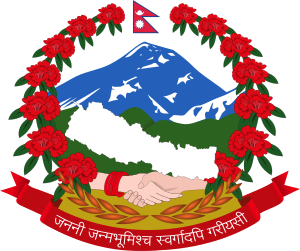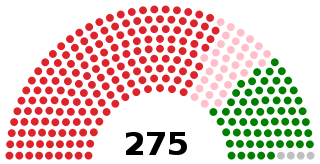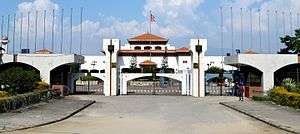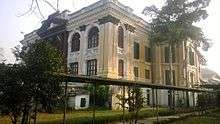House of Representatives (Nepal)
The House of Representatives (Nepali: प्रतिनिधि सभा; Pratinidhi Sabha) is the lower house of the bicameral Federal parliament of Nepal, with the Upper house being the National Assembly.[1] Members of the House of Representatives are elected through a parallel voting system. They hold their seats for five years or until the body is dissolved by the President on the advice of the council of ministers. The house meets in the International Convention Centre in Kathmandu.
House of Representatives प्रतिनिधि सभा | |
|---|---|
 Emblem of Nepal | |
| Type | |
| Type | |
Term limits | 5 years |
| History | |
| Preceded by | Rastriya Panchayat |
| Leadership | |
Speaker | |
Deputy Speaker | vacant since 20 January 2020 |
Leader of the House | |
Leader of the Opposition | |
| Structure | |
| Seats | 275 |
 | |
Political groups | Government (174)
Opposition (101)
|
| Elections | |
| Mixed member majoritarian: | |
Last election | 26 November and 7 December 2017 |
Next election | 2022 |
| Meeting place | |
 | |
| International Convention Centre, New Baneshwor, Kathmandu, Nepal | |
| Website | |
| hr | |
The House has 275 members; 165 elected from single-member constituencies by first-past-the-post voting and 110 elected through proportional electoral system where voters vote for political parties, considering the whole country as a single election constituency.[2] The House of Representatives, unless dissolved, continues to operate for five years from the date appointed for its first meeting. However, in a state of emergency, the term of the House of Representatives may be extended, not exceeding one year in accordance with federal law.
The current House of Representatives was elected in 2017 and its first meeting was held on 5 March 2018.[3]
History
The House of Representatives was first provided for by the "Constitution of the Kingdom of Nepal 1990", which replaced the former panchayat system of parliament with a bicameral parliament.[4] It consisted of 205 members directly elected from single member constituencies. It had five-year terms, but it could be dissolved by the King on the advice of the Prime Minister before the end of its term.[5]

In May 2002, the House of Representatives was dissolved by King Gyanendra on advice of the then prime minister, Sher Bahadur Deuba, in order to hold new elections.[6] Elections could not take place due to the ongoing civil war, which eventually led King Gyanendra to stage a royal coup. Following the democracy movement of 2006, the King reinstated the earlier legislature.[7] On 15 January 2007, the House of Representatives was transformed into an Interim legislature. This consisted of members appointed under an agreement between the Seven Party Alliance and the Communist Party of Nepal (Maoist).[8]
Parliament of Kingdom of Nepal (1959–1962)
The 1959 constitution of the Kingdom of Nepal, proclaimed on 12 February 1959, first mentions the Pratinidhi Sabha first as follows: "There shall be a Parliament which shall consist of His Majesty and two Houses, to be known respectively as the Senate (Maha Sabha) and the Pratinidhi Sabha (House of Representatives)" (Article No. 18, Constitution of the Kingdom of Nepal, 1959).[9]
The 1959 constitution was abrogated on 16 December 1962, when a new Constitution (Constitution of Kingdom of Nepal, 1962) was proclaimed and the parliament of the Kingdom of Nepal became unicameral.[10]
Membership
The composition and powers of the house are established by Parts 8 and 9 of the Constitution of Nepal. The qualifications for becoming a member of the House are laid out in Article 87 of the Constitution and House of Representatives Election Act, 2017. Members must be :
- a citizen of Nepal
- twenty five years or older on date of nomination
- without a criminal offense conviction involving moral turpitude
- not disqualified by any federal law
- not hold any office of profit (paid by the government).[11]
In addition to this, no member can be a member of both the House of Representatives and the National Assembly.
Vacation of seat
The seat of a member of House of Representatives may be considered vacant in the following circumstances:[12]
- if they resign in writing to the Speaker or Chairperson,
- if they do not meet the requirements under Article 91,
- if their term of office expires or if the term of the House of Representatives expires,
- if they remain absent from ten consecutive meetings without notification to the House,
- if the party of which they were a member when elected provides notification in the manner set forth by law that they have abandoned the party,
- if they die.
Composition by province
| Province | Constituencies |
|---|---|
| Province No. 1 | 28 |
| Province No. 2 | 32 |
| Bagmati | 33 |
| Gandaki | 18 |
| Province No. 5 | 26 |
| Karnali | 12 |
| Sudurpashchim | 16 |
Elections for the House of Representatives
| Legislative Election | Term | |
|---|---|---|
| Start | End | |
| 1991 Nepalese legislative election | May 1991 | August 1994[13] |
| 1994 Nepalese legislative election | October 1994 | May 1999[14] |
| 1999 Nepalese legislative election | May 1999 | May 2002[15] |
| 2017 Nepalese legislative election | March 2018 | |
Speakers
| Name | Took office | Left office | Notes |
|---|---|---|---|
| Daman Nath Dhungana | 1991 | 1994 | [16][17] |
| Ram Chandra Poudel | 1994 | 1999 | [17] |
| Taranath Ranabhat | August 1999 | May 2002 | [18][17] |
| Subash Chandra Nemwang | 2013 | 2015 | [17] |
| Onsari Gharti Magar | 19 October 2015 | 15 October 2017 | [19][20] |
| Krishna Bahadur Mahara | 10 March 2018 | 1 October 2019 | [21][22] |
| Agni Sapkota | 26 January 2019 | Incumbent | [23] |
Current membership by party
| Party | Parliamentary Party leader | Seats | |
|---|---|---|---|
| Nepal Communist Party | Khadga Prasad Oli[24][25] | 174 | |
| Nepali Congress | Sher Bahadur Deuba[26] | 63 | |
| Janata Samajbadi Party, Nepal | Mahantha Thakur | 34 | |
| Independent | 4 | ||
| Total | 275 | ||
See also
- Rashtriya Sabha
- Rastriya Panchayat
- Elections in Nepal
- Parliament of Nepal
References
- "Nepal government in minority after Prachanda's party withdraws support". indiatvnews.com. 12 July 2016. Retrieved 16 December 2017.
... Dahal said the party decision has been conveyed to President Bidhya Devi Bhandari, Prime Minister Oli and Pratinidhi Sabha (Lower House of the Nepali Parliament) Speaker Onsari Gharti. But an official said the politically unstable nation's leader would not immediately resign.
- Article 86 (2) Constitution of Nepal
- "First meeting of House of Representatives concluded". The Himalayan Times. 2018-03-05. Retrieved 2018-03-15.
- http://archive.ipu.org/parline-e/reports/arc/2386_91.htm
- "parliament". nepaldemocracy.org. Retrieved 16 December 2017.
- "Nepal king dissolves parliament". telegraph.co.uk. 21 May 2002. Retrieved 16 December 2017.
- "Nepal's king restores parliament". theguardian.com. 24 April 2006. Retrieved 16 December 2017.
- "Legislative Branch Reform: Comprehensive Peace Agreement". peaceaccords.nd.edu. Retrieved 16 December 2017.
- "The Constitution of the Kingdom of Nepal, 1959" (PDF). www.constitutionnet.org/vl/item/constitution-kingdom-nepal-1959. Retrieved 29 March 2018.
- "Nepal-Salient Features of the New Constitution" (PDF). www.icwa.in. Retrieved 29 March 2018.
- "Constitution of Nepal 2006, as amended to 2015". constitutions.unwomen.org. Retrieved 16 December 2017.
- "Constitution of Nepal". Constitute.
- "Kingdom of Nepal: Parliamentary Elections, May 12, 1991". ifes.org. 31 May 1991. Retrieved 16 December 2017.
- "NEPAL Parliamentary Chamber: Pratinidhi Sabha ELECTIONS HELD IN 1994". archive.ipu.org. Retrieved 16 December 2017.
- "NEPAL Parliamentary Chamber: Pratinidhi Sabha ELECTIONS HELD IN 1999". archive.ipu.org. Retrieved 16 December 2017.
- http://kathmandupost.ekantipur.com/news/2017-11-03/dhungana-makes-a-comeback-to-politics-after-23-years.html
- https://myrepublica.nagariknetwork.com/news/mps-back-ecs-proposal-of-providing-it-authority-to-announce-poll-dates/
- https://www.telegraph.co.uk/news/1394997/Nepal-king-dissolves-parliament.html
- "First female Speaker Magar assumes office". kathmandupost.com. Retrieved 2020-01-26.
- "Parliament dissolved". The Himalayan Times. 2017-10-14. Retrieved 2020-01-26.
- "Krishna Bahadur Mahara elected Nepal parliament's Speaker". The New Indian Express. Retrieved 2020-01-26.
- Sharma, Bhadra (2019-10-01). "Parliament Speaker in Nepal Resigns After Rape Accusation". The New York Times. ISSN 0362-4331. Retrieved 2020-01-26.
- "Sapkota becomes Speaker amid concerns from conflict victims and rights watchdogs". kathmandupost.com. Retrieved 2020-01-26.
- "UML and Maoist Centre to form Nepal Communist Party tomorrow". 16 May 2018.
- "Nepal: Left alliance unifies to form single party". www.aninews.in.
- "Deuba elected NC PP leader". Retrieved 2018-03-26.
